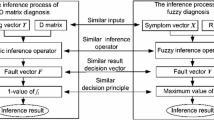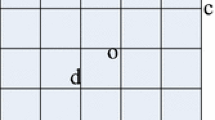Abstract
For the purpose of detecting the state of systems or equipment, and isolating the internal faults in the field of testability, a method of establishing the dependency integrated matrix based on diagonally dominant fuzzy transitive matrix is proposed. The principle of dependency integrated matrix is introduced. On the basis of fuzzy transitive modeling towards the faults and the signs of systems or equipment under detection, the fuzzy transitive matrix is achieved [1]. Furthermore, according to the diagonally dominant matrix, the zero rows (rows with all zero elements) of dependency matrix are settled, and the dependency integrated matrix applied to fault detection is proposed based on the transitive relationship between the faults and the symptoms with the maximum degree of membership [2, 3]. The flow of establishment for dependency integrated model is described in detail. The statistics of a certain circuit are taken as an example for application, which demonstrates this method is feasible and effective.
Access this chapter
Tax calculation will be finalised at checkout
Purchases are for personal use only
Similar content being viewed by others
References
Choi GS, Iyer RK, Saleh R, Carreno V (1991, January) A fault behavior model for an avionic microprocessor: A case study. In Dependable computing for critical applications. Springer, Vienna, pp 177–195
Goode PV, Chow MY (1993, November) Neural/fuzzy systems for incipient fault detection in induction motors. In industrial electronics, control, and instrumentation, 1993. proceedings of the IECON’93., international conference on (pp 332–337). IEEE
Isermann R (1984) Process fault detection based on modeling and estimation methods—a survey. Automatica 20(4):387–404
Shi JY (2011) Testability design analysis and verification. In National Defence Industry Press, pp 90–119
Kahraman C, Ertay T, Büyüközkan G (2006) A fuzzy optimization model for QFD planning process using analytic network approach. Eur J Oper Res 171(2):390–411
Liu H, Zhao W, Zhang J, Wang L, Ma X, Zhao F (2011, May) Modal analysis of machine tools during working process by matrix perturbation method. In: Assembly and manufacturing (ISAM), 2011 IEEE international symposium on (pp 1–4). IEEE
Liu WY (1993) The fuzzy functional dependency on the basis of the semantic distance. Fuzzy Sets Syst 59(2):173–179
Yang P, Qiu J, Liu GJ (2008) Research on extended dependency model-based testability analysis. Systems Engineering and Electronics, February 2008, pp 371–374
Patton RJ, Hou M (1998) Technical communique: design of fault detection and isolation observers: a matrix pencil approach. Automatica (J IFAC) 34(9):1135–1140
Priya RD, Sujitha S, Jeevitha S (2013) Estimation of age group most affected by various reasons for the drop outs of the students in coimbatore by using fuzzy matrix. Int J Math Arch (IJMA) ISSN 2229-5046, 4(4)
Shi JY, Lin XG, Shi M (2012). A key metric and its calculation models for a continuous diagnosis capability base dependency matrix. Metrol Meas Syst 19(3):509–520
Tian Z, Shi JY (2013). System testability design, analysis and verification. Beijing, China
Shi JY, Zhang X, Zou TG (2011) Application of multi-signal modeling and diagnosis strategy design technology. Syst Eng Elect 33(4):811–815
Shi J, Lin X, Lv K (2012, May) A method for searching and evaluating diagnosable sequence fault sets of a dependency matrix. In: Prognostics and system health management (PHM), 2012 IEEE conference on (pp 1–7). IEEE
Shi J, Zhang T, Wang F (2012, May) A data pre-processing method for testability modeling based on first-order dependency integrated model. In: Prognostics and system health management (PHM), 2012 IEEE Conference on (pp 1–8). IEEE
Trampert J, Fichtner A, Ritsema J (2013, April) Estimating resolution in full waveform tomography. In: EGU General Assembly Conference Abstracts (vol 15, p 3098)
Author information
Authors and Affiliations
Corresponding authors
Editor information
Editors and Affiliations
Rights and permissions
Copyright information
© 2015 Springer International Publishing Switzerland
About this paper
Cite this paper
Zhang, T., Shi, JY., Peng, YY. (2015). A Method of Establishing the Dependency Integrated Matrix Based on Diagonally Dominant Fuzzy Transitive Matrix. In: Tse, P., Mathew, J., Wong, K., Lam, R., Ko, C. (eds) Engineering Asset Management - Systems, Professional Practices and Certification. Lecture Notes in Mechanical Engineering. Springer, Cham. https://doi.org/10.1007/978-3-319-09507-3_110
Download citation
DOI: https://doi.org/10.1007/978-3-319-09507-3_110
Published:
Publisher Name: Springer, Cham
Print ISBN: 978-3-319-09506-6
Online ISBN: 978-3-319-09507-3
eBook Packages: EngineeringEngineering (R0)




